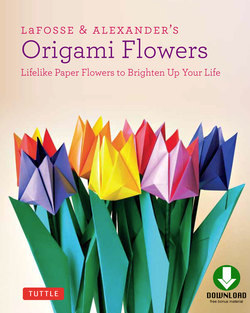Читать книгу LaFosse & Alexander's Origami Flowers Ebook - Michael G. LaFosse - Страница 11
На сайте Литреса книга снята с продажи.
ОглавлениеTechniques and Tools
Origami flowers are skill builders! The repetition required for producing any bouquet will help you remember the steps, and make a skilled folder of you. The more you fold, the sooner you will discover your own favorite tools and techniques. Here are ours:
Use a folding tool. At first, most folders use the back of their thumbnail to burnish a crisp crease, but soon, many use tools. So called “bone folders” are handy for placing precise creases, and for opening layers to “squash” a fold. These are effective whether they are made of real bone, metal, wood, stone, or plastic—even the bowl of a picnic spoon works well.
An inexpensive plastic bone folder makes quick work of the task of sharpening creases, and saves wear and tear on your nails.
“Wet folding” is popular because it makes paper folding easier. When paper is moistened, the paper is more yielding, and capable of being curled or shaped with a soft crease or gentle touch. When it dries, it hardens and retains its shape. Use a fine spritz from a plant-misting bottle, but don’t add too much moisture! The paper should never feel wet—merely supple, cool, or pliant, like thin leather. Try this technique by misting the paper when curling the petals of the Rose for Irene (page 80) or the Modular Six-Piece Day Lily (page 56).
A plant mister can deliver just the right amount of moisture to ease folding.
A sharp cutting system—whether it is a straight edge and craft knife with new blade, or a good pair of scissors—is essential for cutting your paper accurately to the correct size and shape. Some of these projects require cutting the squares in halves or quarters. Similarly, you may want to make smaller versions of these flowers by quartering the squares. You will someday run out of paper that comes with this kit, so you will want to cut up found papers.
A collection of common cutting tools.
Assembling origami plant and flower components is fun, but choose the correct materials so that your work will look neat, and will last. Water based adhesives are safe, effective, and inexpensive to use. We use a small paint-brush, wooden toothpick, or cotton swabs for applying paste or glue sparingly. Keep a small container of water and clean cotton swabs handy for promptly removing any excess adhesive, and be sure to clean all of your supplies thoroughly before putting them away.
When joining your paper stems, folded leaves, and blossom components, we find it handy to have a pair of small jewelery pliers with an integrated cutter, ready to help trim and shape florist’s wires, producing a neater, more realistic effect.
TIP: A collection of brightly colored blossoms has a cumulative effect where the whole is greater than the sum of its parts.
Did you forget to stop by the florist? A few squares of paper can keep you out of the doghouse.
